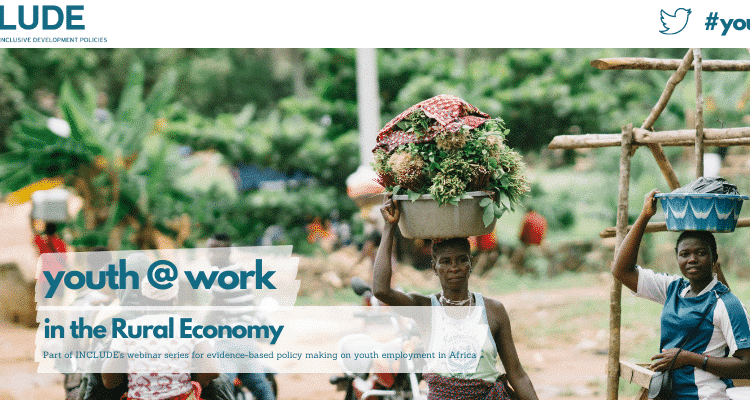
By Ninja Lacey and Maya Turolla
How to address the missing job crisis through green and digital jobs, while assuring that none is left behind? By using the latest knowledge base on the topic, our recently published evidence synthesis paper series provides a number of potential solutions. They were discussed in the webinar series Youth@Work, from which we present five key insights.
1. Framing the issue: from youth employment crisis to missing job crisis
Addressing the issue of youth employment in Africa needs to be framed accurately to design effective strategies. The mainstream narrative is that the responsibility and capacity to find and create employment lays mainly with youths. But in fact, Africa’s ‘youth employment’ crisis is, in many ways, actually foremost a ‘missing jobs’ crisis – or rather, a missing jobs crisis, as the majority (80%) of the workforce is engaged in the informal sector. Nevertheless, the economy is growing without generating employment for youth: making it a ‘jobless’ economic growth. Reframing the mainstream narrative from a youth employment crisis to a missing jobs crisis creates a more accurate understanding of the problem and is therefore a pre-requisite for change.
2. Structural transformation: invest in small and big enterprises
Addressing the ‘missing jobs crisis’ leads us to consider structural transformation as one of the key strategies to address systemic hurdles to private sector. Structural economic transformation seeks to capitalize on the potential of small- and medium-sized enterprises to create employment for young people in Africa. SME’s are estimated to provide up to 80% of jobs across the continent and contribute strongly to economic and social development in society. Policies that stimulate (small) enterprise development are therefore essential to bring about youth employment in Africa.
3. Digitalization & the future of work
Africa is going digital – and when digitalisation is sufficiently inclusive, it creates a world of opportunities for African youths to acquire jobs. But the high cost of internet data and unreliable and expensive electricity provision means that especially the most marginalised groups in society may be excluded from the potential benefits of the digital revolution. Next to this, lack of social protection within digital labour is a problem. One of the promises of the digital economy for youth employment is related to ‘crowdwork’, a form of employment that uses internet-based platforms to provide services or products for profit. But these crowd-workers are misclassified as independent contractors and are therefore excluded from existing labour regulations and social protection, making platform workers extremely vulnerable and often exploited. Such challenges reveal the complexity of providing and safeguarding decent and inclusive labour within the digitalised world. To create truly inclusive youth employment, the divide must be bridged between those who have access to digital labour opportunities – and those who don’t.
4. Green jobs and agricultural transformation
Despite the many opportunities presented by digitalisation and the tech economy, agriculture is expected to remain the largest job-supplier in the coming decades – though many jobs within the sector will be transformed to respond to climate change. Projections estimate that around half of Africa’s employment opportunities remain in rural areas until at least 2030. But agricultural livelihoods are increasingly threatened by climate change. Climate action is therefore closely linked to the employment prospects of youth in Africa and the transition to a green economy is all the more important. This transformation is anticipated to create new ‘green jobs’, and is therefore widely heralded as a solution to the missing jobs crisis in Africa. However, a green transformation of the economy will also displace existing jobs. The green transformation must therefore also be a ‘just transition’, implemented carefully and inclusively, with social protection schemes in place for those who lose their jobs during the transition.
5. Meaningful youth participation: the crosscutting pathway
Meaningful youth engagement needs to go beyond tokenism towards real participation. Marginalized groups must be supported specifically to overcome their particular barriers to participation. Youth participation can take different forms, ranging from information provision through to consultation, shared decision-making and co-management, all the way to autonomy. The nature and quality of participation determines the extent to which young people’s voices are heard. The notion of ‘nothing about them, without them’ cannot be stressed more. Efforts to stimulate youth employment should capitalise on youth’s agency and allow them to sit in the driver’s seat.
Interested to learn more? Visit INCLUDE’s Youth @ Work webpage




